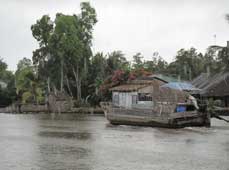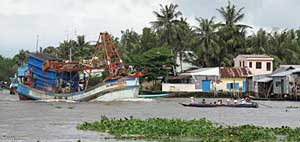In Southern people’s memories, Miet thu in the Mekong Delta is a deserted land where ‘muoi keu nhu sao thoi, dia lenh tua banh canh’ (mosquitoes buzz like the sound of flutes and leeches are much like noodles) and where people listen to the tranquil sounds of monkeys and birds.

However, on Monday, Miet thu U Minh is an attractive destination for nature enthusiasts who are suffocated with city life and want to discover something more rustic, peaceful and green on weekend breaks or holidays.
In the past, the road to Miet thu was challenging but now it is really easy. From HCMC, tourists can take a bus via Phuong Trang, Mai Linh or Thanh Buoi bus companies to Rach Gia. From there, tourists take a boat trip on Cai Lon River to Miet thu or pass Tac Cau Ferry then take a bus for 60 kilometers to reach their destination. Thankfully the small and muddy road has now been replaced by a larger concrete surface.
Reaching Tac Cau ferry and heading along Xeo Ro Canal, visitors will meet around 11 areas of miet thu along Thailand Gulf, belonging to An Minh and An Bien District in Kien Giang Province, running up to the edge of U Minh Forest. In a drizzly morning of the wet season, Miet thu welcomed us with its endless green cajuput, fragrance of vast rice fields, busy ambience on interlacing canals but also the changes of modern life.
Miet thu is no longer home to just mosquitoes, marine species or wild animals, but also of many residents. They live, work and turn the deserted lands into a colorful and lively destination. The never-ending green cajuput now is studded with yellow cottages, grey iron roofs and colorful housing and stores.
It is mostly farmers who reside here raising bees in the cajuput forest or raising shrimp, cattle and rice. If someone thinks Miet thu is still a backward land, they are wrong and should keep that idyllic childhood memory as just that, a memory. In the thinly-populated area, visitors can find guest houses equipped with air-conditioning, telephones and internet. Amidst cottages or concerted houses on canals are electronic, motorbike, fruit, food, grocery and school stationery stores. However, Miet thu still preserves its rustic customs. Tourists will see many girls in ao ba ba (traditional costumes of Southern women) and conical hats, instead of the decollete, tank-tops or miniskirts of modern girls in the city.

On the road, you rarely hear the modern music of pop, R&B and jazz, but cai luong or don ca tai tu (Southern opera) is prevalent.
The floating market in Miet thu, with its system of entangled rivers and canals is a sight to see. The transportation means of locals in Miet thu is mainly by canoe and wooden boats but they also can be multifunctional as shelter and a place to earn money. Touring to Miet thu, tourists will be surprised by the busy wharfs.
In the river’s intersections there is a floating market where larger boats become floating houses that sell many kinds of products, but mainly agricultural products and food. Small boats also drift along the canal to sell to households living far from the markets.
It is very easy to know what is up for grabs. Buyers just see what they hang on a stick on the tip of the boat.
The market doesn’t have time constraints or boat rules and regulations as every available boat can come and sell what they have at any time of the day or night. Unlike other floating markets in the delta which are often busier in the early morning, Miet thu markets are busier at night. Under the dim lights of noisy boats and the calls of traders, the market never seems to sleep.
After a cruise on the floating market, a trip to Miet thu must include a dinner on one of the floating restaurants. Miet thu is famous for fresh seafood, honey and especially crab.
Staying overnight in Miet thu under a flickering camp fire and enjoying don ca tai tu is an experience you won’t forget.